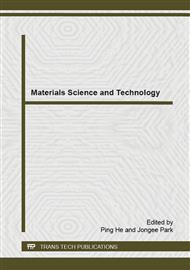p.3
p.9
p.15
p.21
p.26
p.32
p.38
p.42
Amine-Functionalized Graphene for Natural Gas Sweetening
Abstract:
Natural gas is often contaminated with acid gases; commonly hydrogen sulfide (H2S) andcarbon dioxide (CO2). In addition to their offensive odor and high toxicity, acid gases can cause serious corrosion problems in a gas plant due to their acidic nature and may reduce the efficiency of gas treatment processes. Therefore, several natural gas sweetening processes have been developed for the removal of acid gases. In present work, we report the employment of amine-functionalized graphene hybrid for adsorption of acid gases. Graphene was selected as a solid sorbent due to its very high specific surface area and ability to undergo various chemical transformations.Considering high affinity of amines towards H2S, an aminated polymer, polyethylenimine (PEI) was used as a functionalizing agent. The resulting hybrids were characterized using Fourier Transform Infrared spectroscopy (FTIR), X-ray Photoelectron Spectroscopy (XPS), elemental analysis, X-ray Diffraction analysis (XRD), and Thermogravimetric Analysis (TGA). These hybrids are envisioned as materials with high H2S sorption capacities and hold great promise in natural gas sweetening applications.
Info:
Periodical:
Pages:
21-25
Citation:
Online since:
December 2014
Authors:
Price:
Сopyright:
© 2015 Trans Tech Publications Ltd. All Rights Reserved
Share:
Citation:



